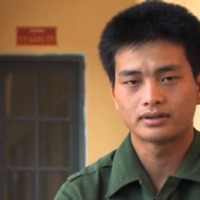
Kim Anh
Despite having the lowest regional prevalence of modern slavery in the world, Europe remains a destination, and to a lesser extent, a source region for the exploitation of men, women and children in forced labour and commercial sexual exploitation. Trafficking for sexual exploitation is the most widespread for of modern slavery with an 84% of victims trafficked for this purpose. The majority of those trafficked for this purpose are women and young girls who often originate from Eastern Europe within the EU as well as Sub-Saharan Africa, with the majority of people being trafficked from Nigeria to various parts of Europe including Italy, France, Spain and the UK through an array of complex trafficking networks. Kim Anh faced a bad harvest in her hometown of Nghe An in northern Vietnam. With a family to feed and few prospects for work, she decided to borrow money to go overseas. She had been told by a local man affiliated with a Christian group that she could relocate to any country in Europe for U.S. $14,000. After securing the loans, she paid her fee and began an anxious period of waiting. When the time came for her departure, she felt nervous but knew that her success could secure a happy future for her family. However, instead of securing a future for her family, Kim Anh she was trafficked through Europe and subjected to physical and sexual abuse daily.

Huong
China remains a source, transit and destination country for the sexual exploitation of women and children. Women are lured through false promises of legitimate employment and trafficked into commercial sexual exploitation from countries such as Mongolia, Burma, North Korea, Russia, Vietnam, Romania and Ghana. Moreover, the Chinese government’s birth limitation policy and a cultural preference for sons created a skewed sex ratio of 117 boys to 100 girls in China, which observers assert increases the demand for prostitution and for foreign women as brides for Chinese men—both of which may be procured by force or coercion. Women and girls are kidnapped or recruited through marriage brokers and transported to China, where some are subjected to commercial sex or forced labour. Huong was 19 when her Aunt's boyfriend trafficked her, drugging her drink and selling her to a brothel in China. Subjected to physical and sexual abuse daily, Huong and another girl being held were able to escape with the help of Vietnamese man who drove them to the Vietnam-China border.

Ly
Minority children and those from very poor families are extremely vulnerable to trafficking in China. A highly organised practice exists where couples have children for the very purpose of selling them. Children from minorities are also deceived into trafficking under the false promise of work in hospitality, construction and manufacturing but are instead forced to engage in criminal activity or prostitution. There are also an estimated 1.5 million children currently enslaved as forced beggars in China. Ly was 8 months pregnant when she was trafficked to China for her and her baby to be sold.

Neng
The internal migration of Chinese people seeking work has created an opportunity for human traffickers in China. Moreover the gender imbalance caused by the One Child Policy and the cultural preference for male children, has caused a shortage of women which has led to the trafficking of women to be sold as brides. As a result many women find themselves either deceived by promises of employment, sold or abducted and forced into marrying Chinese men who have paid for them. The prevalence of poverty in China makes the poor more vulnerable to enslavement. With the National Bureau of Statistics estimating that 70,170,000 are still living in poverty, people are more desperate and thus more likely to be receptive to fraudulent job offers. Neng was just 14 when she was taken to China by her cousin who upon arrival forced her to marry a man 15 years her senior. Neng was able to escape and found her way to a shelter that seeks to support young girls who have survived human trafficking.

Qui
China remains a source, transit and destination country for the seuxal exploitation of women and children. Women are lured through false promises of legitimate employment and trafficked into commercial sexual exploitation from countries such as Mongolia, Burma, North Korea, Russia, Vietnam, Romania and Ghana. Qui travelled with a friend to Lao Cai to buy and sell things. After crossing the river, she was picked up by a Chinese man and taken to a hotel. The following day she was forced in to sex work at the age of 15. After 3 years she was final able to escape with the help of the police.

Mai A
The internal migration of Chinese people seeking work has created an opportunity for human traffickers in China. Moreover the gender imbalance caused by the One Child Policy and the cultural preference for male children, has caused a shortage of women which has led to the trafficking of women to be sold as brides. As a result many women find themselves either deceived by promises of employment, sold or abducted and forced into marrying Chinese men who have paid for them. The prevalence of poverty in China makes the poor more vulnerable to enslavement. With the National Bureau of Statistics estimating that 70,170,000 are still living in poverty, people are more desperate and thus more likely to be receptive to fraudulent job offers. Mai, 16, was trafficked from Vietnam into China to be sold as a child bride.

Trong
China remains a source, transit and destination country for men, women and children subject to forced labour. There have been a number of media reports exposing cases of forced labour in the country, especially among the disabled whose families are unable to care for them and with an underdeveloped government support system leaving them vulnerable. The disparity of work opportunities between rural and urban populations has created a high migrant population vulnerable to human trafficking. The lure of a higher income leads many migrant workers to accept jobs in China without knowing exactly what they entail. Trong went to China from Vietnam after his aunt told him he could get housework near the border. He was told he would work for a couple of months and then return home. However upon arrival he was told by other Vietnamese workers that he had been deceived. Trong had been enslaved into debt bondage in a brick kiln, forced to work to cover the costs of transportation and accommodation. Eventually Trong along with his friend Lin were able to escape.

Thien
China remains a source, transit and destination country for the sexual exploitation of women and children. Women are lured through false promises of legitimate employment and trafficked into commercial sexual exploitation from countries such as Mongolia, Burma, North Korea, Russia, Vietnam, Romania and Ghana. Thien was trafficked in to forced prostitution after a friend stole her bicycle and told her she would have to work to earn money to retrieve it. Thien was taken by boat from Vietnam to China where she was forced to work in multiple prostitution dens. Subjected to physical violence and food deprivation, Thien attempted to escape on numerous occasions. After a year she was finally able to escape when she stole a customer’s phone and wallet and ran to a nearby bus station.

Lin
China remains a source, transit and destination country for men, women and children subject to forced labour. There have been a number of media reports exposing cases of forced labour in the country, especially among the disabled whose families are unable to care for them and with an underdeveloped government support system leaving them vulnerable. The disparity of work opportunities between rural and urban populations has created a high migrant population vulnerable to human trafficking. The lure of a higher income leads many migrant workers to accept jobs in China without knowing exactly what they entail. Lin travelled to China with his friend Trong from Vietnam when he was told he could get housework near the border. He was told his travel expenses, food and accommodation would be taken care of and he would earn a good salary. However, upon arrival he found himself in debt bondage, forced to work long hours under the threat of violence in a brick kiln to pay off his incurred fees. Eventually Lin was able to escape along with his friend Trong, hiding out in a nearby forest to avoid discovery.

Khanh
Foreign workers constitute more than 20 percent of the Malaysian workforce and typically migrate voluntarily—often illegally—to Malaysia from Bangladesh, India, Nepal, Burma, Indonesia, the Philippines, and other Southeast Asian countries, mostly in pursuit of better economic opportunities. Some of these migrants are subjected to forced labour or debt bondage by their employers, employment agents, or informal labour recruiters when they are unable to pay the fees for recruitment and associated travel. Khanh was looking for work to help her family when a neighbour offered to help her work in Malaysia. After being given money to enter as a tourist, Khanh was taken to the house where she would work. Forced to work long hours on little sleep, Khanh was under constant surveillance and subjected to physical abuse. Though she tried to escape a number of times, it was only when the daughter of the family she worked for came to visit that she was able to escape, hiding in the boot of her car.